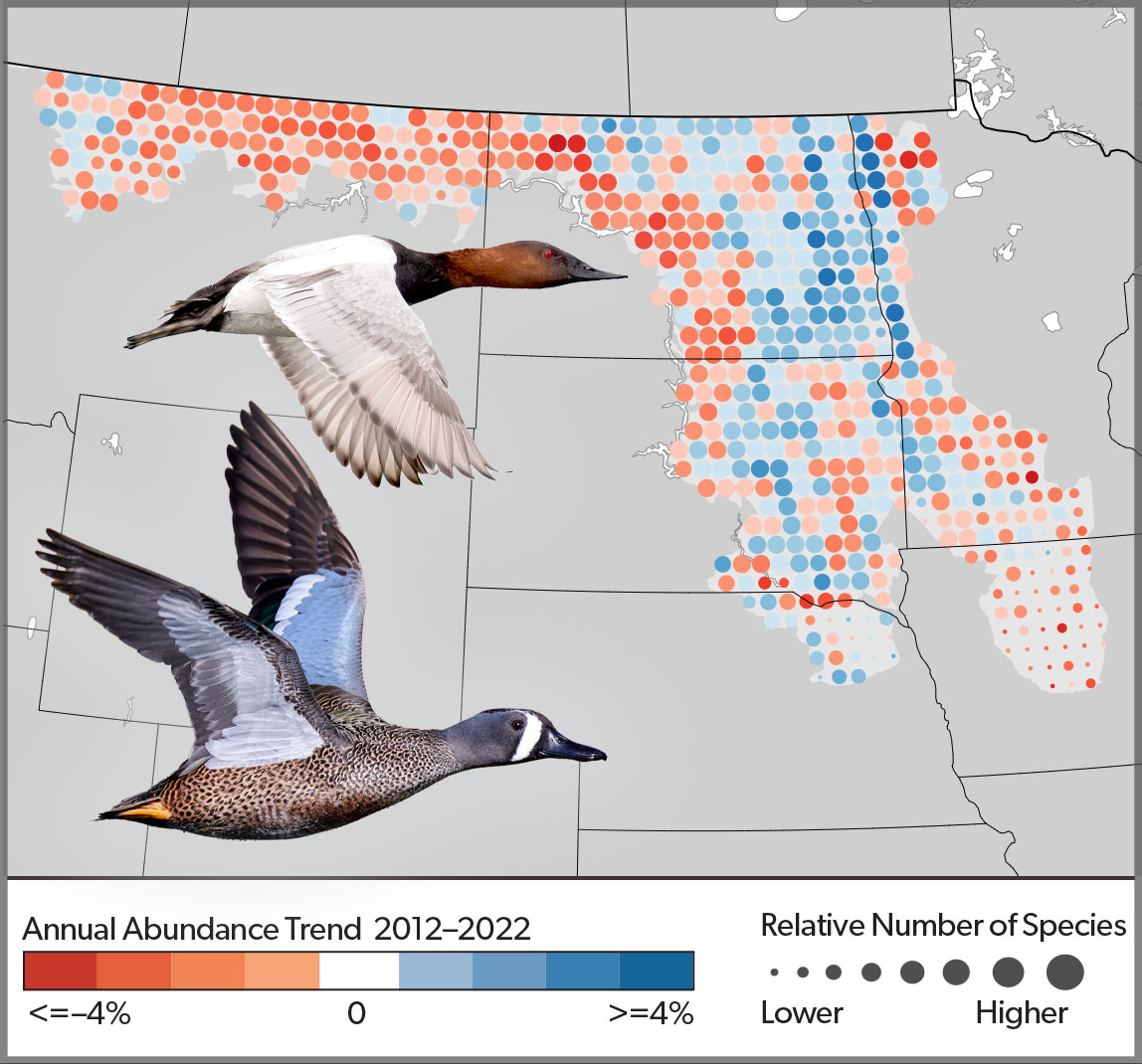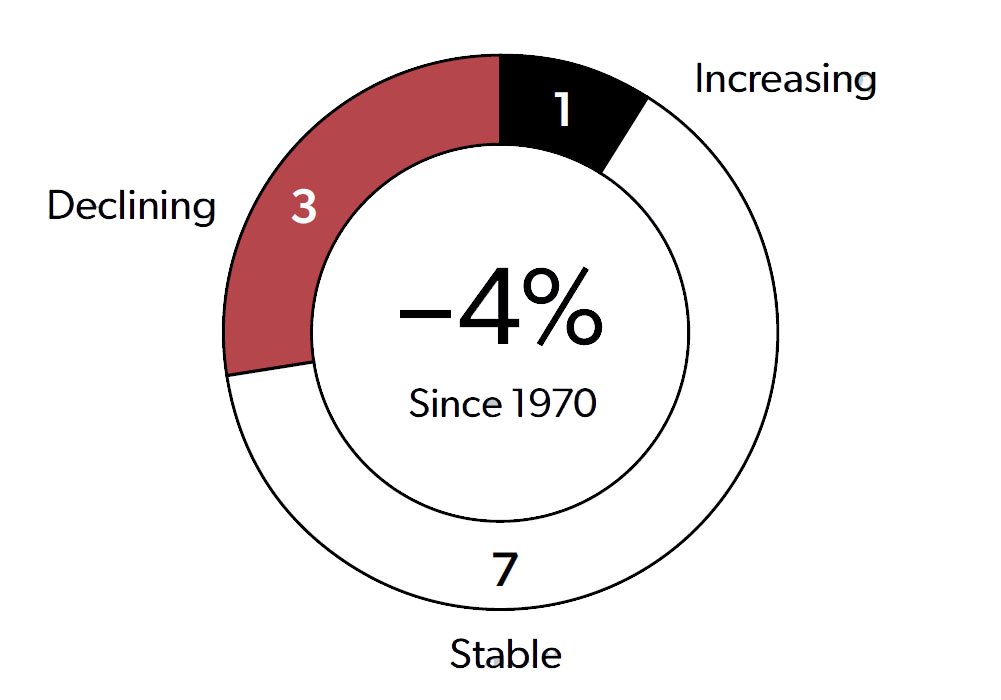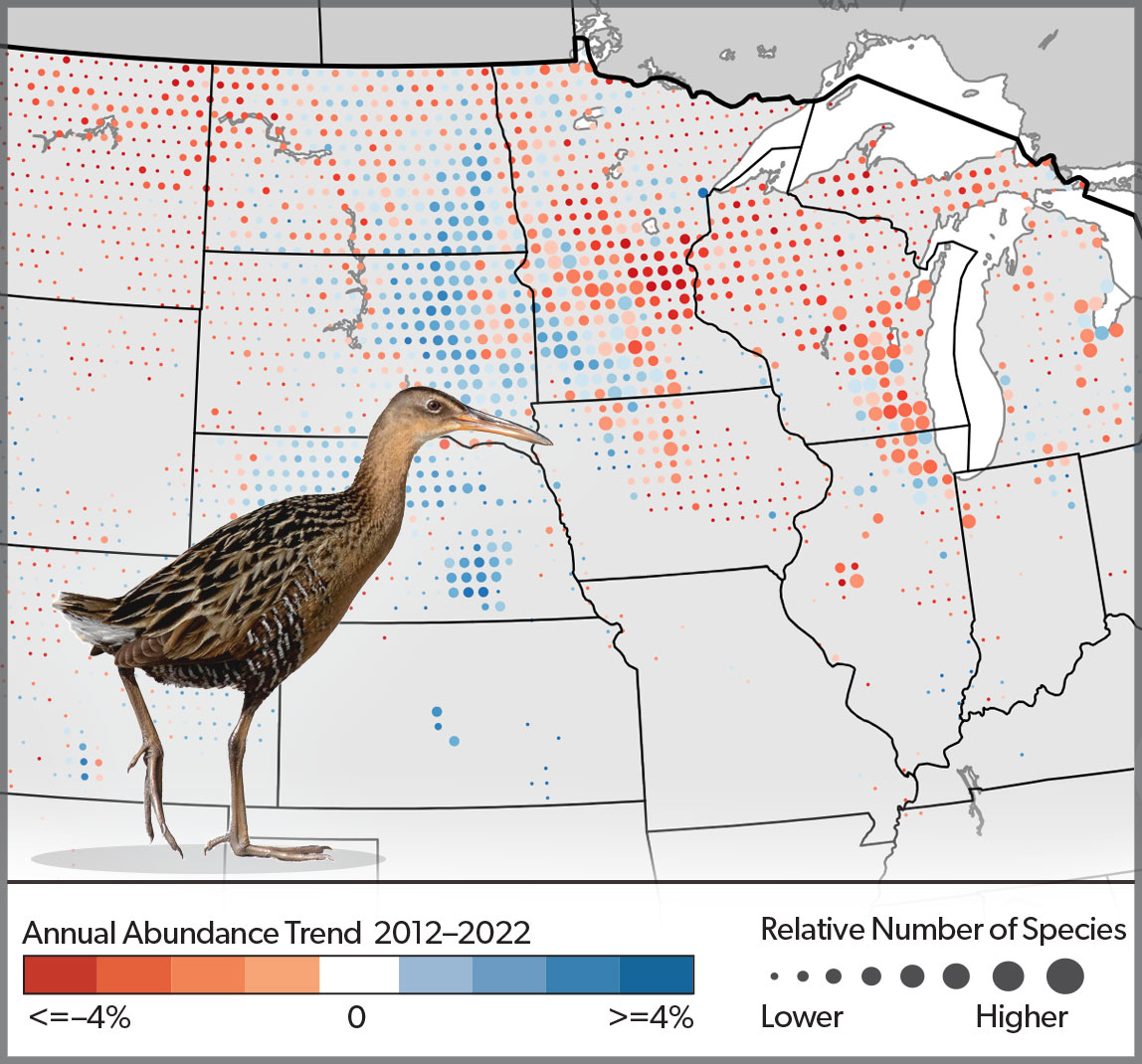Waterfowl and Waterbirds
Long-term gains level off, renewing conservation concerns
In past State of the Birds reports, waterfowl and waterbirds were the only groups that showed population gains, with waterfowl showing the greatest increases. Duck populations now are 24% higher than they were in 1970—the result of foundational policies (such as the North American Wetlands Conservation Act, Duck Stamp program, and Conservation Title of the Farm Bill) that have long safeguarded wetland resources and associated habitats.
But today this legacy is in jeopardy. Loss of wetlands and grasslands is accelerating in key regions for waterfowl, and wetland protections are being weakened. Environmental and land-use changes are driving recent duck and marsh bird declines in many areas. Protecting America’s waterfowl and waterbird conservation legacy means living up to the policy pledge of no-net-loss of wetlands and delivering creative solutions that provide diverse benefits to wetland birds, agricultural producers, and broader society.
No-Net-Loss-Wetlands Policy Is Not Being Achieved
Bipartisan support for a “no-net-loss” of wetlands federal policy has been strong since it was first announced by President Bush in 1989. Yet the latest U.S. Fish and Wildlife Service Wetlands Status and Trends report shows that the annual rate of wetlands loss increased by more than 50% over past decades, with a staggering 670,000 acres of net loss among the vegetated wetlands that are crucial to the nation’s ecological health.
The main drivers of wetlands loss include drainage and filling for agriculture, development, and silvicultural operations. Rebuilding America’s wetland complexes begins with defending the wetlands policy protections that remain. In particular, the Swampbuster provision of the Farm Bill has been vital to retaining wetlands and supporting populations of waterfowl, waterbirds, and shorebirds in agricultural landscapes.
The long-term resiliency of duck populations and other wetland birds absolutely depends on keeping a strong base of wetlands intact.
Dabbling and Diving Ducks
The Prairie Pothole Region (PPR) is North America’s most important area for breeding ducks, supporting as much as two-thirds of the continental population. But over the past decade duck populations in the PPR have declined and are now 10% below the long-term average.


Many waterfowl rely on grassland–wetland habitat complexes for breeding. The combination of grassland and wetland loss in the Dakotas and Montana is rolling back decades of waterfowl population gains built by conservation policies such as the federal Duck Stamp and North American Wetlands Conservation Act. Blue-winged Teal by Sharif Uddin / Macaulay Library; Canvasback by Caroline Lambert / Macaulay Library.
-
Duck Breeding Habitat at Risk
Recent duck declines in the Prairie Pothole Region (PPR) correspond with a period of deteriorating environmental conditions and unrelenting wetland and grassland loss, driven by the expansion and intensification of row-crop agriculture and erosion of wetland protections.
-
Farm Bill Conservation Programs Can Boost Ducks
Voluntary conservation programs implemented via the Farm Bill, such as the Conservation Reserve Program (CRP), have proven successful in supporting duck populations. But CRP acres have declined by half across the PPR since 2007.
-
Voluntary Conservation Is Popular in Farm Country
More than 7 in 10 farmers support expanding voluntary conservation programs to provide financial support for healthy farms. Local communities benefit, too, as PPR wetlands conserved by Farm Bill programs† capture billions of gallons of floodwaters.
† U.S. Geological Survey. 2008. Ecosystem services derived from wetland conservation practices in the United States Prairie Pothole Region with an emphasis on the U.S. Department of Agriculture Conservation Reserve and Wetlands Reserve Programs.
American Black Duck
American Wigeon
Black-bellied Whistling-Duck
Blue-winged Teal
Canvasback
Cinnamon Teal
Common Merganser
Fulvous Whistling-Duck
Gadwall
Greater & Lesser Scaup
Green-winged Teal
Hooded Merganser
Mallard
Mottled Duck
Northern Pintail
Northern Shoveler
Redhead
Ring-necked Duck
Ruddy Duck
Wood Duck
Sea Ducks
Across the expansive range of sea ducks, from the Arctic tundra to seacoasts and the Great Lakes, rapidly warming waters are affecting crucial food resources. One-third of sea ducks are Tipping Point species, including Steller’s, Spectacled, and King Eider, as well as Black Scoter and Long-tailed Duck.


Christmas Bird Count (CBC) numbers for Common Eiders are declining along the Northeast coastline, as eiders shift their wintering range away from the Gulf of Maine—where water temperatures are warming at nearly three times the rate of global oceans. This eider population shift increases the importance of other key sea duck habitat sites along the Atlantic Coast. Common Eider by Jeremiah Trimble / Macaulay Library.
-
Protecting Nearshore Coastal Habitats Is Crucial
The Sea Duck Joint Venture has identified 85 key habitat sites essential for sea duck populations. These critical habitats are at risk from warming ocean temperatures, wind energy, shipping, commercial fishing, aquaculture, and other industrial development.
-
Indigenous Partnerships Can Strengthen Conservation Efforts
There is an important opportunity for tribal partnerships in sea duck conservation, as many sea duck species are culturally significant to Indigenous peoples and can enhance food security for northern communities.
-
Improved Sea Duck Monitoring is Greatly Needed
Scientists need reliable data to understand sea duck population declines and distributional changes, and to inform innovative solutions to help sea ducks survive in the changing oceans and northern habitats of the future.
Barrow’s Goldeneye
Black Scoter
Bufflehead
Common Eider
Common Goldeneye
Harlequin Duck
King Eider
Long-tailed Duck
Red-breasted Merganser
Surf Scoter
White-winged Scoter
Waterbirds
The upward trend for the waterbirds group is driven by growing populations of fish-eating species, such as pelicans—a testament to the lasting impact of the Clean Water Act. But more than a third of waterbird species are declining. Secretive marsh birds, such as King Rail and Black Rail, are affected by the loss of vegetated wetlands.


Declines among secretive marsh birds are occurring in the Upper Midwest. Alternative strategies for remaining wetlands, many of which are actively managed for high-quality duck habitat, could provide shallow water and robust vegetation and benefit marsh birds while continuing to support duck populations. King Rail by Jeremiah Trimble / Macaulay Library.
-
Wetlands Management Needs to Do More for Birds
Given significant wetlands losses, creative management strategies are needed to ensure the nation’s shrinking wetlands can support broad suites of wetland-dependent birds, including waterfowl and secretive marsh birds.
-
Proactive Management Can Avoid ESA Listings
More inclusive wetland management strategies can help keep at-risk wetland species such as King Rail off endangered species lists, thereby avoiding expensive regulations and litigation. The Eastern Black Rail was recently listed due to habitat loss.
-
Wetlands Can Benefit Every Bird and Everybody
Holistic wetlands management, delivered at larger scales, promotes full ecosystem health. Healthier wetlands deliver added benefits to people, including clean, abundant water and reduced flood risks.
American Bittern*
American Coot
American Herring Gull
American White Pelican
Anhinga
Black Skimmer
Black Tern
Black-crowned Night Heron
Bonaparte’s Gull
Brown Pelican
California Gull
Caspian Tern
Clapper Rail*
Common Loon
Common Gallinule*
Common Tern
Double-crested Cormorant
Eared Grebe
Forster’s Tern
Franklin’s Gull
Glaucous Gull
Glaucous-winged Gull
Glossy Ibis
Great Black-backed Gull
Great Blue Heron
Great Cormorant
Great Egret
Green Heron
Gull-billed Tern
Heermann’s Gull
Horned Grebe
King Rail*
Laughing Gull
Least Bittern*
Least Grebe
Least Tern
Limpkin
Little Blue Heron
Neotropic Cormorant
Pacific & Arctic Loon
Pied-billed Grebe
Purple Gallinule*
Red-necked Grebe
Red-throated Loon
Reddish Egret
Ring-billed Gull
Roseate Spoonbill
Royal Tern
Sandhill Crane
Sandwich Tern
Short-billed Gull
Snowy Egret
Sora*
Tricolored Heron
Virginia Rail*
Western Cattle-Egret
Western & Clark’s Grebe
Western Gull
White Ibis
White-faced Ibis
Wood Stork
Yellow-billed Loon
Yellow-crowned Night-Heron
*The 8 starred species were used in the eBird Trends analysis of secretive marsh birds (above).
